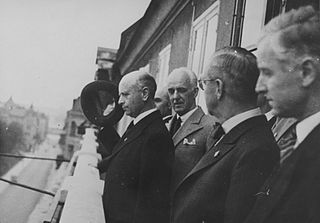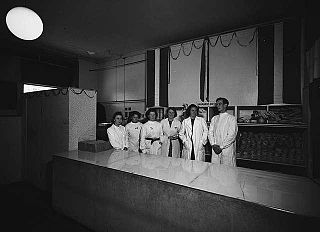
The Norwegian campaign involved the attempt by Allied forces to defend northern Norway coupled with the resistance of the Norwegian military to the country's invasion by Nazi Germany in World War II.

Tormod Kristoffer Hustad was the Norwegian minister of agriculture in the 1940 pro-Nazi puppet government of Vidkun Quisling, provisional councilor of state for agriculture in the government appointed by Reichskommissar Josef Terboven in 1940, and minister of labour in the NS government 1942–1944. He was replaced by Hans Skarphagen in 1944. In the post-war legal purges he was convicted of treason and sentenced to life imprisonment and forced labour.

Birger Ljungberg was a Norwegian military officer and politician from the Conservative Party who served as Minister of Defence from 1939–1942.
Atle Thowsen is a historian and the Director of the Bergen Maritime Museum and served as president of the International Commission for Maritime History from 2000 to 2005.

The Norwegian Legation in Stockholm played a significant role during the Second World War. Until 9 April 1940 the legation consisted of four persons, and at the end of the war about 1,100 persons were connected to the legation. Refugee cases were among the legation's most central tasks. In 1941 a Military office was established, and this was later split into separate offices for intelligence, and for Milorg related cases.
Tore Gjelsvik was a Norwegian geologist and polar explorer. He headed the Norwegian Polar Institute from 1960 to 1983, and played an important role in the Norwegian resistance during World War II.
Jan Birger Jansen was a Norwegian physician, anatomist and scientist, specializing in brain research. He played an important role in the Norwegian civil resistance during the Second World War.
Norsk krigsleksikon 1940–1945 is a Norwegian encyclopaedia covering the Second World War.

Danish humanitarian aid to Norway during World War II, in Norway called Norwegian: Danskehjelpen and in Denmark called Danish: Norgeshjælpen, was initiated in 1941 and resulted in 32,000 tons of food supplies from Denmark to occupied Norway.
Swedish humanitarian aid to Norway during World War II, in Norway called Norwegian: Svenskehjelpen and in Sweden called Swedish: Svenska Norgehjälpen, amounted to around SEK 71 million. High priority was extra food for schoolchildren in Norway. In 1944 more than 100,000 portions of soup were administered daily from almost 1,000 distribution centrals.
Ragnvald Alfred Roscher Lund was a Norwegian military officer, with the rank of colonel. He was a military attaché at the Norwegian legation in Stockholm in 1940. He served as head of the Office FO II at the Norwegian High Command in exile in London during World War II, responsible for Military Intelligence.
The milk strike was a strike in Nazi-occupied Oslo on 8 and 9 September 1941. It led to strong reprisals from the German occupiers, in the form of martial law, court-martial, mass arrests, two executions and several long-term jail sentences.
Odd Fossum was a Norwegian shop assistant, and leader of the Norwegian Confederation of Trade Unions from 1941 to 1945, under the Nazi regime during the occupation of Norway by Nazi Germany. He was also the leader of NS Faggruppeorganisasjon from 12 October 1940 to September 1944, when he was succeeded by Olav M. Hoff.
The Norwegian High Command was Norway's top military leadership from 1970 to 2003. It was established in Northern Norway in 1940 by General Otto Ruge. It was then re-established by the Norwegian Government-in-exile in London in 1942, lasting until 1946. The High Command was re-established in 1970, lasting until 2003, when a different organization was formed.
The theatre strike in Norway in 1941 was a conflict between Norwegian actors and Nazi authorities, during the German occupation of the country. The strike involved theatres in the cities of Oslo, Bergen and Trondheim. The strike started on 21 May 1941, as a response to the revocation of working permits for six actors, after they had refused to perform in the Nazified radio. It lasted for five weeks.
Werner Knab (1908–1945) was a German SS-Sturmbannführer (major). He served at the German legation in Norway from 1939, and then as head of Gestapo in Norway from 1940 to 1942, during the occupation of Norway by Nazi Germany. Among others, he led a crackdown on the University of Oslo following the milk strike, and also acted as prosecutor in the court-martial set up in the strike's wake. He died in Germany.
Hans Latza (1908–1975) was a German SS-Obersturmbannführer. He served as SS-judge in Munich from 1939 to 1940, in Prague in 1940, and in Oslo from 1940 to 1945. Latza was the principal judge at SS- und Polizeigerat in Norway. He was responsible for more than 25 death sentences. In the legal purge in Norway after World War II Latze and two co-judges were prosecuted for war crimes for their role when five persons had been sentenced to death in a court-martial reprisal following the assassination of police chief Karl Marthinsen, but Latza was acquitted by the Supreme Court in 1948.
Thor Olaf Hannevig was a Norwegian shipmaster. During the Norwegian Campaign in 1940 he was in command of an army unit called the Telemark Infantry Regiment, and this regiment was able to withstand the German forces until 5 May. Hannevig later acquired a legendary heroic status, and his story was the basis of the 1993 Norwegian film The Last Lieutenant.
Egil Lindberg was a Norwegian radio officer and Secret Intelligence Service agent during World War II.
Finn Nagell OBE was a Norwegian military officer, Milorg pioneer, economist and businessperson.






